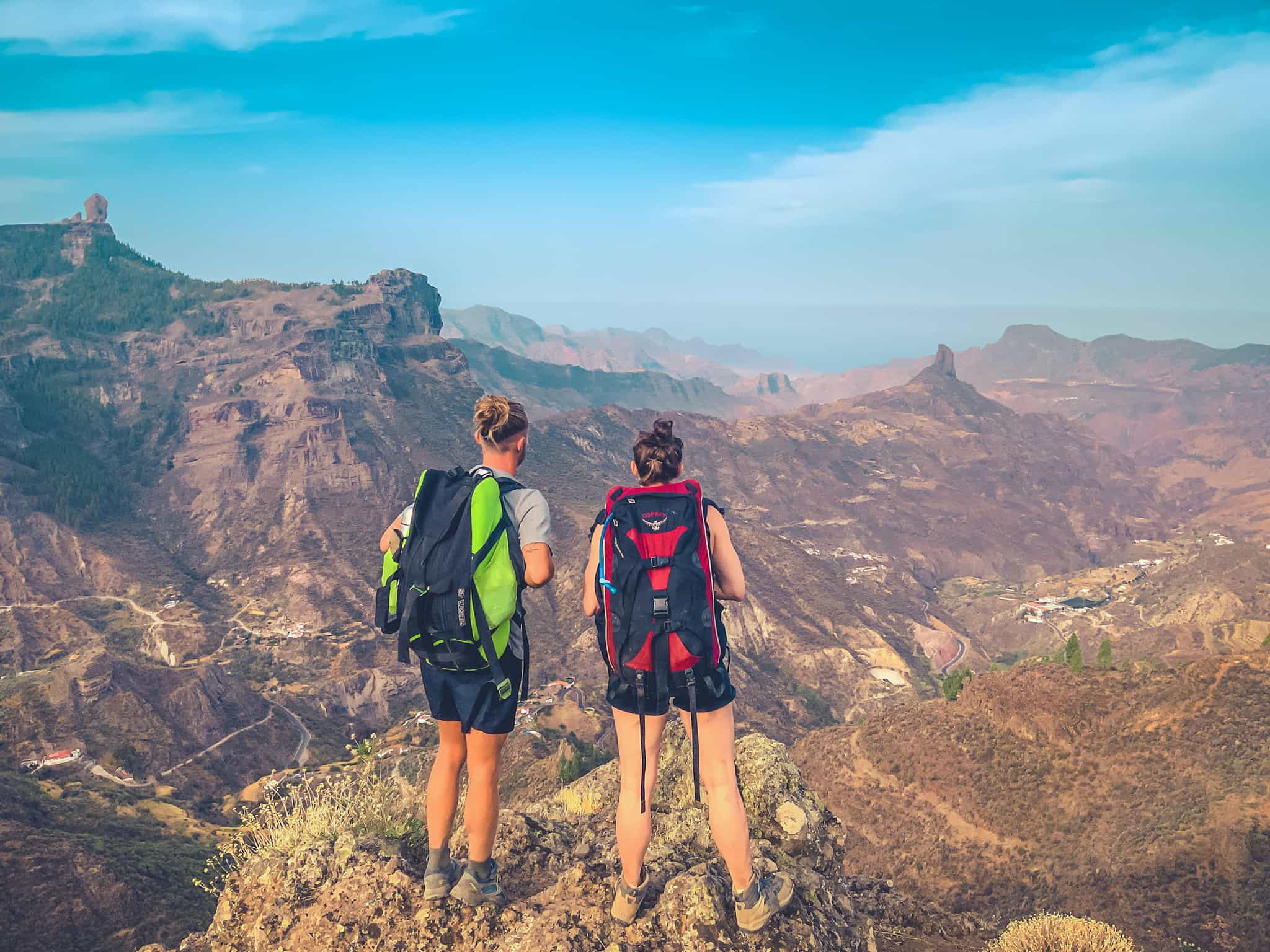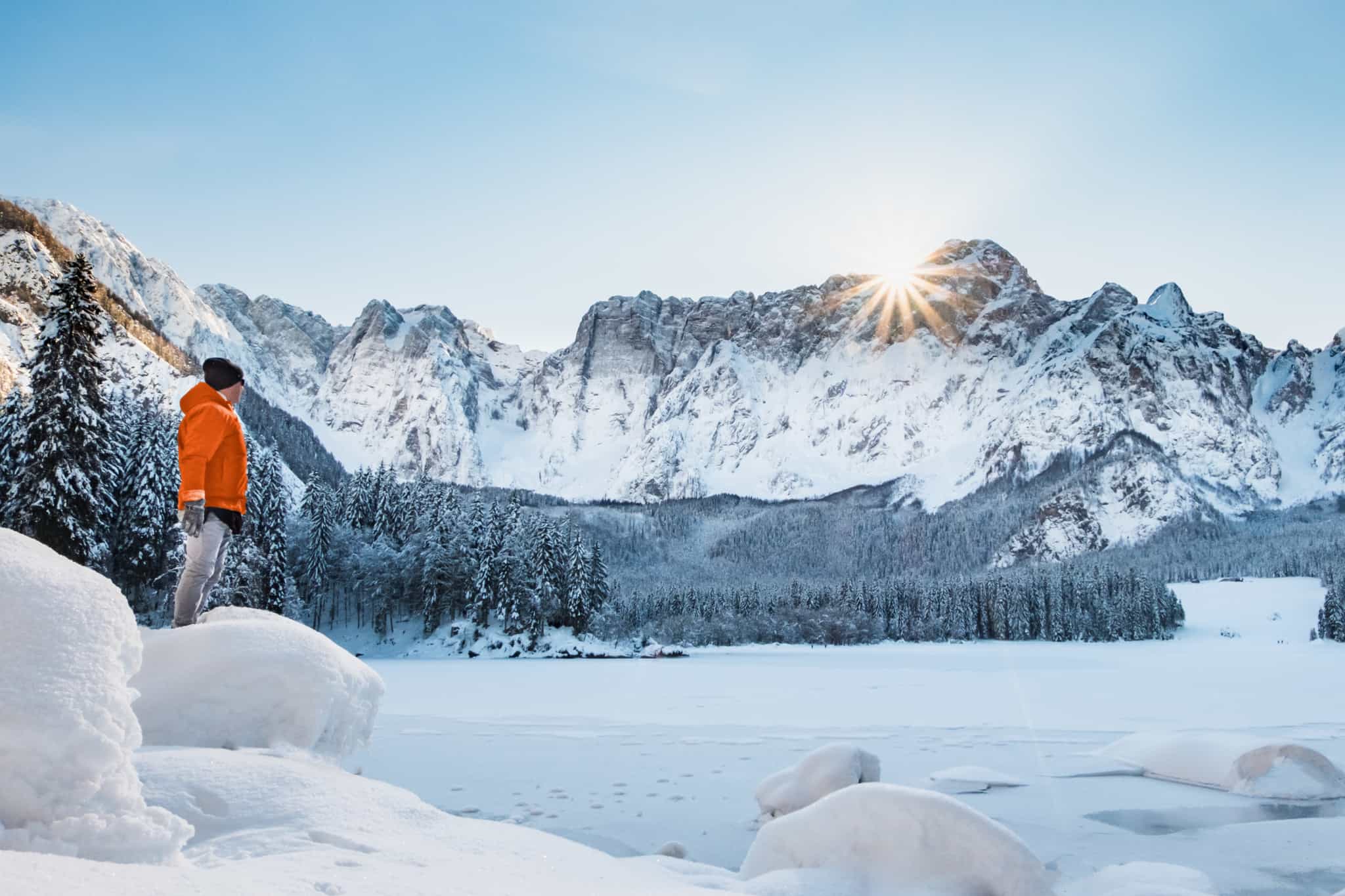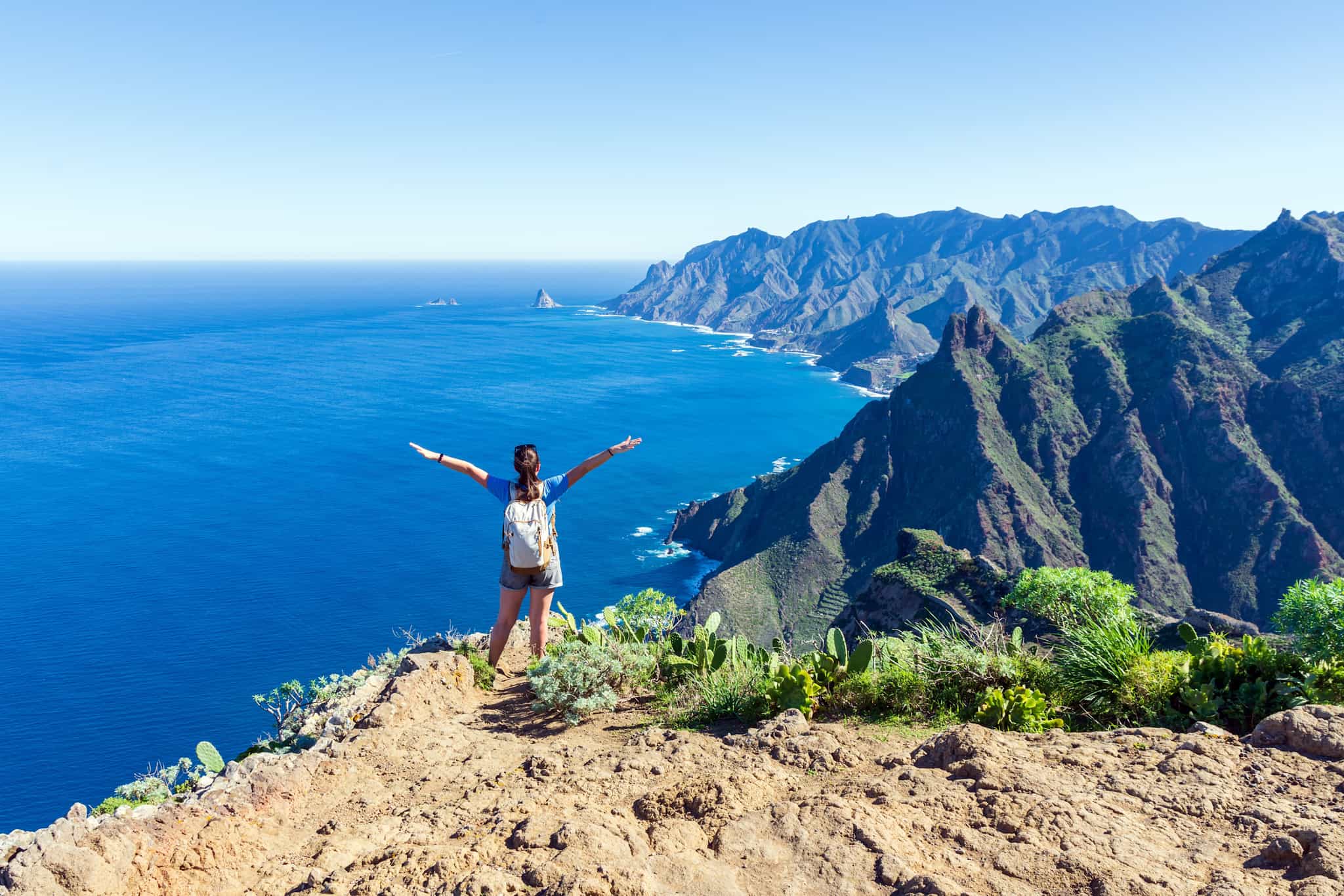Where to Go Hiking in Europe in December
The best places to go hiking in Europe in December vary wildly based on the conditions you’re chasing.
If you’re dreaming of a winter wonderland, a place of powdery snow and icicles dripping from wind-struck trees, you’ll want to look to the colder reaches of Europe - the likes of Arctic Norway, Lahemaa National Park in Estonia or the Highlands of Scotland. Mountainous areas like the Alps are also natural choices, and it's not hard to avoid crowds at this time of year, particularly in the likes of Slovenia’s Julian Alps, or the vast Carpathians of Romania.
The other option is to flee from the cold to the warmer spots in European winter. Hike the volcanic islands of Gran Canaria in December and you can find true winter sun. Portuguese islands like the Azores and Madeira are also popular but in this list we've instead opted for the coasts of Albania, which offers hikers routes along the Ionian Sea with no chance of snow; and none of the summer crowds.
What’s the Weather Like for Hiking in Europe in December?
Make no mistake, Europe is a big continent, and the weather varies wildly depending on which region you visit. In the Alps, for example, snow dominates in winter, and the high trails become routes for winter hiking, snowshoeing or ice climbing. The lower valleys can remain accessible, however, and the crisp air and short daylight hours shows you a really different side to Europe’s wild places.
Scandinavia and Eastern Europe offer a more austere experience. Think forests weighed down by snow and bent by wind; mountains wrapped in frost, with temperatures (often far) below freezing. There’s a quiet power to these landscapes.
The Highlands of Scotland tend to see their biggest snowfalls closer to spring, but it is likely the mountain tops will be sprinkled with at least a bit of snow here too.
Across Southern Europe, from Spain’s toasty coast and the Sierra Nevada mountains to Greece’s Peloponnese to the islands off the south of the continent, temperatures are milder, and the winter sun makes for good walking conditions.
Rainy downpours can (and will) happen from time to time but this is a wonderful time of the year to explore areas which, in summer, can be overcrowded.
Why Go Hiking in Europe in December?
Hiking in Europe in December is not about tackling multi-day classics. The likes of the Alta Via in the Dolomites and the Tour du Mont Blanc in the Alps are buried beneath the winter snow. Instead, it’s about solitude and sensory precision. This is a month for moving slowly through frosty dreamscapes; about fine details like jagged icicles or the crunch of a boot in the snow. Areas which are often busy in summer tend to be significantly quieter at this time of year, and locals can be more relaxed (unless there's a popular ski resort in close proximity, in which case their workload can even increase). In the warmer places, all of the above remains true - although of course, you can still get those big landscapes and dusty trails.
Best Hiking Destinations in Europe in December
Here, we've led with eight snowy destinations for winter hiking, and included two beauties for December sun at the end.
It can be easy to get lost in winter, and often conditions simply do not permit hiking - so ensure you have a local guide to find the spots and keep you safe.
Now, without further ado...
1. Alta, Norway
- Average daytime temperatures: -4°C (24.8°F) to -2°C (28.4°F)
- Average nighttime temperatures: -15°C (5°F) to -10°C (14°F)
- Best for: Snowshoeing, Arctic hiking, aurora watching
About the area: Alta sits on the inner reaches of the Altafjord, at the edge of the vast Finnmarksvidda plateau in northern Norway, a landscape of frozen rivers, birch woods, and open tundra. Here you can stay in canvas domes and look for the northern lights while you sleep, then explore by snowshoe or on foot by day.
Why hike here in December? The polar night creates a surreal lightscape. Hours of blue twilight are followed by the dance of the aurora. It’s a season for slow, deliberate movement through Arctic stillness.
Must-do trail(s): Komsa Hill provides a quick ascent above the fjord; snowshoe to frozen lakes in the forest interior.
What’s the weather like? Bitterly cold and often dry, with wind and snowdrift on open ground. Light is limited to a few hours of dim daylight.
What to know before you go: Snowshoes or skis are often essential beyond town. Avalanche gear is required in deeper terrain or near canyon rims. Headlamps and insulated batteries are non-negotiable. Roads can ice over quickly and public transport runs infrequently.
2. Fort William, Scotland
- Average daytime temperatures: 4°C (40°F) to 7°C (44.6°F)
- Average nighttime temperatures: 1°C (33.8°F) to 3°C (37.4°F)
- Best for: Valley and glen walks, low-level hikes, winter photography
About the area: Fort William is the gateway town to Ben Nevis, the highest mountain in Scotland and the UK. This is where Atlantic storms meet Highland slopes. The result is a landscape of glens, lochs, and extraordinary beauty.
Why hike here in December? Fort William is a dreamland in winter for those experienced enough to safely navigate the winter landscape - or those keen to learn how to do so. Low paths remain accessible, while the mountains turn white above. Winter brings solitude, reflection, and an elemental sense of the Highlands, but it also brings with an opportunity for budding mountaineers to learn winter skills.
Must-do trail(s): Ascend Ben Nevis in winter - a pursuit strictly only to be undertaken with an experienced guide, or by experienced mountaineers. For an easier walk, check out the Upper Glen Nevis and Steall Falls route.
What’s the weather like? Wet and windy, with frequent rain and cloud wrapping the peaks. Snow usually lies higher up. Forecasts are unpredictable.
What to know before you go: Days are short and conditions can shift quickly. Summit routes demand full winter kit and navigation skills. Expect flooding on valley paths and check mountain forecasts before setting out.
3. Lahemaa National Park, Estonia
- Average daytime temperatures: -2°C (28.4°F) to 1°C (33.8°F)
- Average nighttime temperatures: -5°C (23°F) to -7°C (19.4°F)
- Best for: Flat, contemplative hiking through bogs and pine forest
About the area: Lahemaa lies on Estonia’s northern coast, a mosaic of bogland, coastal pine, and quiet villages. It's just an hour from Tallinn but don't let that confuse you - this is a true wilderness, mixing coast, snowy trails and forests.
Why hike here in December?: The bogs freeze, the forests fall silent, and fog drifts through the trees. Winter pares the landscape to its essentials. You have a slightly better chance of spotting lynx - although they remain rare - as they're easier to see against the snow.
Must-do trail(s): The Viru Bog boardwalk and the Käsmu Peninsula trail are both atmospheric and accessible in winter.
What’s the weather like?: Calm, cold, and humid, with frequent frost and patches of fog near the coast.
What to know before you go: Boardwalks can become extremely slippery. Microspikes are recommended and snowshoes for deeper walks. Daylight fades by mid-afternoon, and most local cafés and services close early.
4. The Julian Alps, Slovenia
- Average daytime temperatures: 0°C (32°F) to 3°C (37.4°F)
- Average nighttime temperatures: -5°C (23°F) to -8°C (17.6°F)
- Best for: Forest and plateau hiking, snowshoeing
About the area: This limestone range rises above the famous towns of Bohinj and the postcard-perfect town of Bled. The Julian Alps blend alpine drama with quiet forests and karst plateaus. These mountains are every bit as beautiful and dramatic as the Alps elsewhere, but less crowded. A sensational spot.
Why hike here in December? The higher peaks are under snow and all the more dramatic for it, but the plateaus and valleys remain open, offering calm winter scenery away from ski crowds.
Must-do trail(s): The Pokljuka plateau offers wide forest routes, and the Triglav National Park offers hikes like Vrsic peak, possible with a guide in winter.
What’s the weather like? Cold and still, often clear after snowfall. Temperature inversions can leave the valleys in fog while ridges shine in sunlight.
What to know before you go: Mountain huts close for the season. Carry winter equiptment and navigation tools. Roads over major passes may close entirely.
5. The Apuseni Mountains, Romanian Carpathians
- Average daytime temperatures: -1°C (30.2°F) to 2°C (35.6°F)
- Average nighttime temperatures: -6°C (21.2°F) to -9°C (15.8°F)
- Best for: Gorge walks, forest hikes, snow-covered ridge routes
About the area: The Carpathians curve across central Romania, from the limestone gorges of Piatra Craiului to the high ridges of the Bucegi Mountains. The Apuseni range is in the western Carpathians. Base yourself at Garda de Sus, and you're in the perfect place to explore the karstic peaks and prehistoric caves here.
Why hike here in December? Forests muffle sound and wind, creating a deep peace. Winter brings a raw clarity to the cliffs and plateaus.
Must-do trail(s): Hike to the top of the karstic Vârtop Cave network - where evidence of Neanderthals was found - and let a guide show you within.
What’s the weather like? Crisp cold with clear, dry spells and heavy snow.
What to know before you go: Trail markings can vanish under snow. Mountain huts close or reduce service, and avalanche information is limited.
6. The Dolomites, Italy
- Average daytime temperatures: 0°C (32°F) to 2°C (25.6°F)
- Average nighttime temperatures: -6°C (21.2°F) to -9°C (15.8°F)
- Best for: Meadow circuits, lower-altitude hiking, winter vistas
About the area: The Dolomites are one of Europe's legendary landscapes. Located in northeast Italy, bordering Austria, the spiky, fingered form of the rocks makes this area particularly recognisable - and the extensive WW1 history adds another dimension to the visitor experience here.
Why hike here in December?: High-pressure weather brings calm, clear days. While the ski resorts draw the crowds, the valley paths and meadows remain quiet.
Must-do trail(s): Hike to the renowned Rà Stua Hut. From here, you can then hike on day trips out (with a guide - and ARTVA avalanche transceivers)!
What’s the weather like?: Often sunny with cold, dry air. Shaded paths remain icy through the day.
What to know before you go: Many rifugi and lifts are closed. Some high passes shut for the season; check access before traveling. Bring winter equipment.
7. The Abruzzo Mountains, Italy
- Average daytime temperatures: 2°C (35.6°F) to 5°C (41°F)
- Average nighttime temperatures: -2°C (28.4°F) to -5°C (23°F)
- Best for: Plateau walks, beech forests, quiet winter hiking
About the area: The Abruzzo area, in the Central Apennines, combine open highlands with deep valleys and UNESCO-protected forests - just a couple of hours from the (relative warmth of) Rome.
Why hike here in December?: The landscape feels wide and unhurried, with winter light spreading over the Campo Imperatore plateau. These hills may not have the distinctive rock formations of the Dolomites, but the wildlife here is extraordinary. Winter is the perfect time to go walking and wolf tracking.
Must-do trail(s): The Pianoro Le Forme sits at the foot of Mount Meta. Head out here with a guide (snowshoes often required) and look for deer and wolf tracks.
What’s the weather like?: Cold and changeable, with bright, windy spells and sudden snow squalls.
What to know before you go: Refuges and inns may close midweek. Trails can ice over in shaded valleys, and water sources may freeze.
8. Lapland, Finland
- Average daytime temperatures: -8°C (17.6°F) to -12°C (10.4°F)
- Average nighttime temperatures: -15°C (5°F) to -20°C (-4°F)
- Best for: Fell walking, snowshoeing, aurora viewing
About the area: Is there a more iconic December location in the world than Finnish Lapland? In winter, the waterfalls freeze here, becoming collections of huge, jagged icicles. The forests are twisted and bent by the winds and cold and weighed down by trees to look like monsters. The tundra and frozen forests stretch across Finland’s north, dotted with national parks and cabins.
Why hike here in December?: The polar night is long, but the few hours of twilight carry a hypnotic beauty. Trails are well-marked, and silence defines the experience. The emphasis is on little things; the warmth of a salmon soup, the crunch of a snowshoe on fresh powder, the shimmering glint of the northern lights.
Must-do trail(s): Trek out into the Pyhä-Luosto National Park, a snow wilderness of frozen valleys, ravines and tunturis; the remnants of a two-billion year old mountain range. A guide is crucial to help with navigation and tips for staying warm.
What’s the weather like?: Very cold, with dry air and little wind. Light changes from blue to silver before fading entirely.
What to know before you go: Book cabins ahead. Carry insulated gloves and navigation tools. Electronics can fail in extreme cold - keep them close to the body.
9. Gran Canaria, Spain
- Average daytime temperatures: 18°C (64.4°F) to 22°C (71.6°F)
- Average nighttime temperatures: 13°C (55.4°F) to 16°C (60.8°F)
- Best for: Volcanic hiking, ridge routes, winter warmth
About the area: It's time for some winter sun. Gran Canaria is out in the Atlantic Ocean, and is one of Spain's Canary Islands. It rises steeply from the Atlantic, the volcanic peaks dividing lush northern slopes from the arid southern ravines.
Why hike here in December?: This one is pretty obvious. The warm, stable weather and light here make it ideal for winter walking.
Must-do trail(s): The Guayadeque Valley is a great walk for understanding the volcanic origins of Gran Canaria and the three types of craters - explosive, erosive, and collapsed. The hike to Roque Nublo is a must for 360-degree views.
What’s the weather like?: Mostly dry with occasional rain in the north. The temperature drops sharply with altitude.
What to know before you go: Pack layers for cooler conditions in the highlands. Carry ample water with you. Shade is limited here, even in winter.
10. The Albanian Riviera
- Average daytime temperatures: 13°C (55.4°F) to 16°C (60.8°F)
- Average nighttime temperatures: 6°C (42.8°F) to 9°C (48.2°F)
- Best for: Coastal ridge walks, quiet seaside hiking
About the area: Trek among the mountains of Llogara National Park and you'll be mixing stunning views of the Ionian Sea and coastline with rugged summits.
Why hike here in December?: Mild weather and near-empty villages make it a peaceful time to explore here. That's in contrast to the summer, when the place is often overrun with beach-dwellers. On warm day; the view is over the lush green slopes of the Karaburun Peninsula. In colder days, the ridgelines views can combine snow and sea is the same picture frame.
Must-do trail(s): The ridge trails above Llogara Pass are sublime.
What’s the weather like?: Alternates between calm, sunny periods and sudden southern rain.
What to know before you go: Some routes erode after storms. Hiking boots are a good idea. Accommodation is open but limited, and buses are infrequent.
What to Pack for Hiking in Europe in December
Here’s an example kit list for a snowy trip to go hiking in Europe in December. We’ve taken this kit list from our Snow and Saunas in Estonia trip page:
Bags
- Soft overnight duffel bag or luggage
- Daypack (20-30 litres)
- Waterproof liner for rucksack, or drybags
Clothes
- Waterproof and windproof top and bottom
- Down jacket
- Warm fleece or sweater
- Thermal tops and bottoms
- Snow gloves (you may wish to bring two pairs in case one gets wet)
- Warm hat and/or balaclava (you may wish to bring two in case one gets wet)
- Neck gaiter or scarf
- Multiple pairs of wool or synthetic socks
- Warm, waterproof boots
- Flip flops/water shoes
- Swimsuit (for the sauna)
Other
- Universal travel plug adapter
- Power bank or solar charger
- Passports (and visas)
- Travel insurance documents
- Ear plugs
- Suncream
- Personal first-aid kit (inc. blister treatment)
- Personal items (biodegradable toiletries, sanitary wear etc)
- Alcohol hand-gel
- Headtorch or torch
- Reusable water bottle x1 litre (or x2)
- Energy bars and snacks - read our article on Best Hiking Snacks
Here’s an example kit list for packing for a winter sun hiking trip in Europe in December. This is the kit list which features on our Hike the Volcanic Island of Gran Canaria trip page:
Bags
- Overnight soft duffel or rucksack
- Daypack/rucksack (approx 20 litres)
- Waterproof liner/drybag for day bag
Clothes
- Waterproof jacket
- Breathable wicking layers
- Fleece or similar
- Buff or neckscarf
- Shorts Trousers or zip-offs Underwear and socks
- Swimwear
- Sunglasses
- Sunhat
- Warm hat Something to sleep in
- Hiking boots or shoes (worn-in, not sports trainers)
- Sandals
- Thermals (merino ideal)
- Comfortable clothing for evenings spent indoors and outdoors
Other
- Tupperware and cutlery for lunches
- Universal travel plug adapter
- Passports (and visas)
- Travel insurance documents
- Suncream (minimum factor 30) Beach Towel
- Personal first-aid kit (inc. blister treatment)
- Personal items (biodegradable toiletries, sanitary wear etc)
- Toilet kit (toilet paper, biodegradable bags to carry paper to the guesthouses to dispose of)
- Alcohol hand-gel
- 2 x reusable water bottle x1 approx litre capacity each
Optional
- Ear plugs
- Insect repellent
- Energy bars and snacks
- Walking poles can be very useful for long downhill sections
FAQs: The Best Places to Go Hiking in Europe in December
What are the best places to hike in Europe in December?
The best places to hike in Europe in December include the Canary Islands for warm trails, the Dolomites and Julian Alps for snowshoe hiking, and Scotland’s glens for low-level winter walks. Hikers seeking solitude can explore Romania’s Carpathians or Slovenia’s snowy forests. Southern areas like the Albanian coast remain mild and clear.
Is December a good time for hiking in Europe?
December is a good time for hiking in Europe if you are seeking low-light, peaceful landscapes and the otherworldly beauty of widespread snow. Many trails are quieter and landscapes appear more defined in cold light. Navigation, fuelling and staying warm are all trickier, so a guide is key. In southern regions such as Spain, Portugal, and Greece, hiking weather is mild and ideal for day routes.
Which European countries have mild winter hiking weather?
European countries with mild winter hiking weather include Spain, Portugal, Greece, and Cyprus - as well as coastal areas of countries like Albania and Italy. These countries stay relatively warm in December, though of course it remains unpredictable and rainfall does occur. Roughly speaking, the more south you go, the warmer it gets and the southern islands are the most reliable for warmth.
Best European hiking destinations for December sun?
The best European hiking destinations for December sun are the Canary Islands, Madeira, southern Spain, Cyprus and Greece. These locations maintain warm temperatures and long daylight, particularly compared to northern Europe. In the Canary Islands, hikers can follow volcanic trails around Teide National Park or Roque Nublo, while Madeira is known as the island of eternal spring.
What national parks in Europe are open for hiking in December?
National Parks don't shut depending on the time of year in Europe, and so technically, every national park in Europe is open come December time. What you can actually do in that national depends on what trails remain open - and free of snow. On Gran Canaria, Teide National Park allows winter hiking with mild temperatures. Italy’s Abruzzo, Lazio and Molise National Park offers forest and plateau routes, with the possibility for wolf tracking. Finland’s Pyhä-Luosto National Park makes for great snowshoeing. Scotland’s Cairngorms National Park is beautiful in winter. In Eastern Europe, Slovenia’s Triglav National Park and Romania’s Piatra Craiului National Park provide great outdoors options.
What gear do I need for hiking in Europe in December?
For cold-weather hiking in Europe in December, hikers need waterproof boots, layered clothing, gloves, and a warm hat for starters. In snowy regions, add some variety of snowshoes, crampons, gaiters, avalanche gear and trekking poles, depending on conditions. A headlamp is essential because daylight is short. In southern Europe, breathable but windproof clothing is more important than insulation. A waterproof shell protects against rain or snow.
What are the daylight hours for hiking in December in Europe?
Daylight hours for hiking in Europe in December vary widely by latitude. Northern Europe, including Norway and Finland, has fewer than six hours of usable light or even polar night conditions - with no actual sunlight at all. Central Europe, such as Germany, Austria and Slovenia, averages eight hours of daylight. Southern Europe, including Spain, Italy, and Greece, receives about nine to ten hours. For hiking, start early, carry headlamps and check sunrise and sunset times before setting off.
Can you hike in the Scottish Highlands in December?
Yes, you can hike in the Scottish Highlands in December, and it can be majestic - but you need to choose a suitable route. There are plenty of low-level forest walks and glens in Scotland that allow you to access beautiful scenery safely even in December, while high summits generally will require full winter equipment and experience. Check the Mountain Weather Information Service and local avalanche reports before setting off. Know sunrise and sunset times. Carry waterproof clothing, navigation tools and don't hike beyond your comfort zone.
What are the risks of hiking in winter in Europe?
The main risks of hiking in winter in Europe are cold exposure, limited daylight, ice and snow, and navigation errors. Avalanches pose danger in alpine and Nordic regions. Wet weather increases the chance of hypothermia in southern and coastal areas. Trails can close or become unmarked under snow, equipment can fail in the cold and you can get fatigued in heavy winter clothing. Reduce your risk by checking weather forecasts, carrying winter gear, starting early, and informing others of their route. Better yet, hire an expert local guide to keep you safe.
What are the best guided hiking adventures in Europe in December?
The best guided hiking adventures in Europe in December include winter trekking in the Dolomites, snowshoe expeditions in Lapland, and volcanic hikes in the Canary Islands. Much Better Adventures guided groups operate in southern Spain, Albania and more, for hiking without the snow. In Central Europe, local mountain guides lead winter journeys in Slovenia and Romania’s Carpathians. Guided hiking in December ensures safety, navigation support, and local expertise.
Where to book a multi-day winter trekking trip in Europe?
You can book a multi-day winter trekking trip in Europe through reputable adventure travel companies like Much Better Adventures. Popular regions include the Dolomites, the Julian Alps, Lapland, and the Canary Islands. Much Better Adventures offer small-group winter treks with accommodation and transport.
Small group hiking expeditions in Europe in winter
Small group hiking expeditions in Europe in winter are available throughout the continent. Companies like Much Better Adventures organise limited-size groups to ensure safety and personal guidance. Destinations include the Julian Alps in Slovenia, Picos de Europa in Spain, and Gran Canaria’s volcanic ridges are favourites. Group sizes usually range from six to twelve hikers.
Where to join a December hiking trip with local mountain guides?
Much Better Adventures allows budding travellers to join a small group adventure, led by an expert local guide, at any time of year. In December, the Dolomites, the Julian Alps, Finnish Lapland and the Scottish Highlands are favourites for winter hikers. In southern destinations, join a guide to explore the Canary Islands. Local guides know current snow conditions, open trails, and weather risks.
Inspired? Check out our hiking holidays in Europe in December now!
Stay safe out there: Our guides are well-researched, short summaries, designed to inspire but not for navigational purposes. While we strive for accuracy, we cannot guarantee completeness. Outdoor activities come with serious risk, and individuals must take full personal responsibility for their own safety. Much Better Adventures, and the authors, disclaim any liability arising directly or indirectly from the use of the information from this article.










